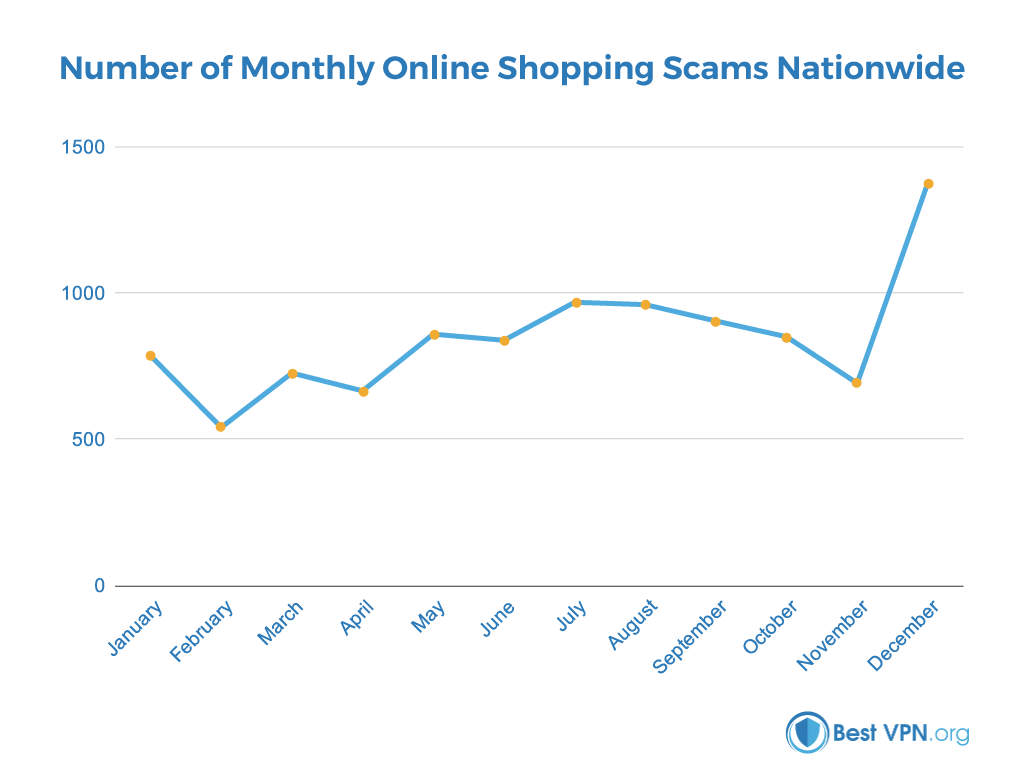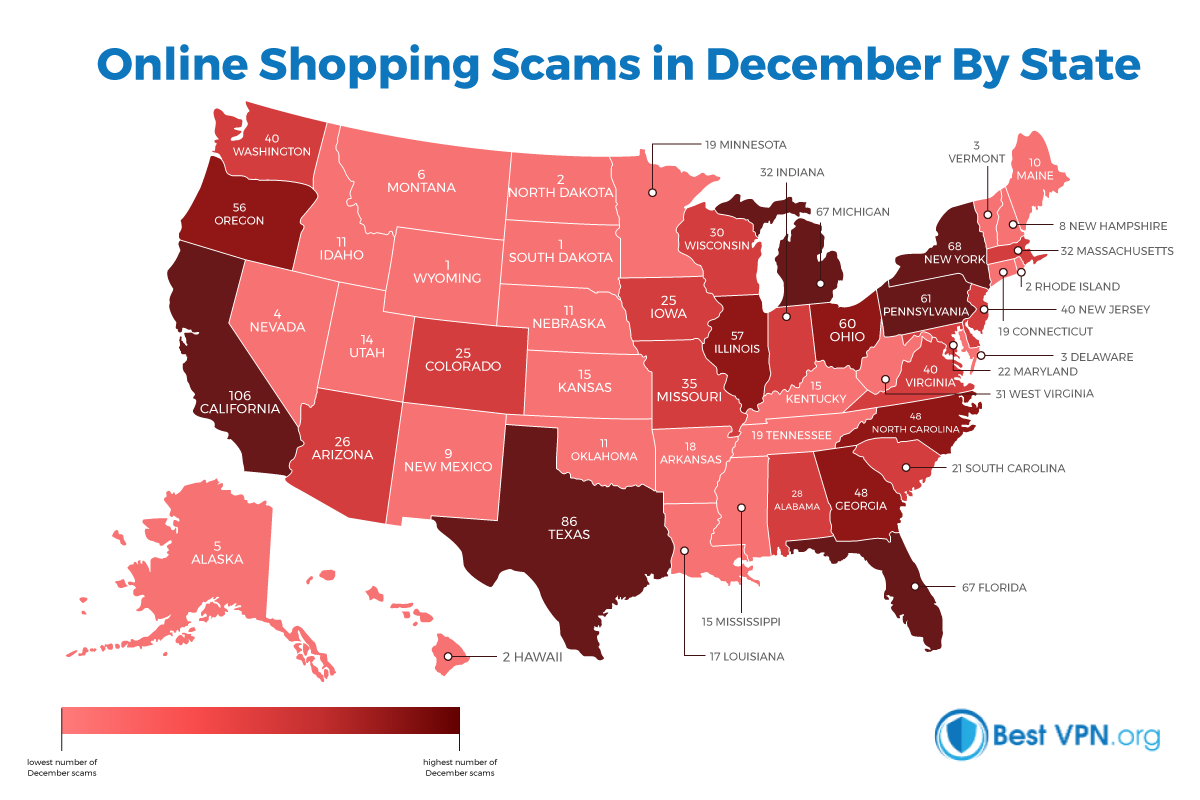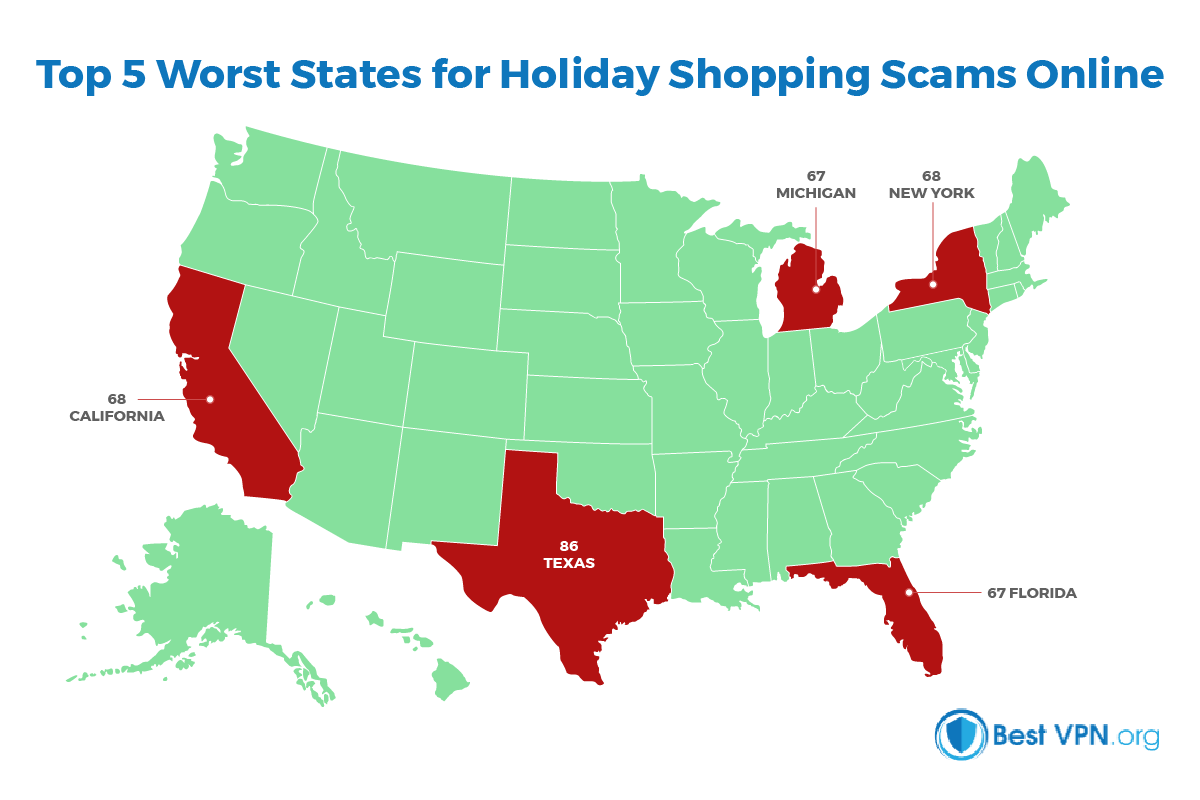Online Shopping Scams During the Holiday Season
For the first time, consumers will do more of their holiday shopping online than they will in brick-and-mortar stores. Fifty-four percent of shoppers plan to do their shopping from their mobile devices this year, as opposed to in-store.
This year marks the first time the shopping scales will tip in favor of online consumerism, according to research from PricewaterhouseCoopers LLP.
While more people plan to shop online this year, there’s a real threat that consumers have to watch out for: online shopping scams.
bestvpn.org compiled data and read hundreds of consumer reports to investigate just how prevalent online shopping scams are, and the results are shocking.
Online shopping scams are 62% higher during the month of December than they are during an average month.
Scams are a problem for residents across the country, but our research revealed several states – California and Texas – are the hardest hit by digital scammers.
To compile this data, we specifically looked at reported cases of online shopping scams from the Better Business Bureau. Keep in mind these are cases that are reported voluntarily by consumers in an effort to warn others from becoming a victim of the same scam and provide a snapshot of online shopping scams that take place.
Online shopping scams happen year-round, but they’re more prevalent during the holiday season. This year, consumers should be aware of potential scams as they shop for holiday gifts online. No matter how a scammer pulls it off, every case can result in lost money.
For protection against holiday scams, shoppers must take precautionary steps this season. Be cautious about ordering products from unknown websites, buying products that are priced extremely low, or purchasing a product that you learned about via an email from an unknown company.
What kinds of scams are most popular?
When you think of online shopping scams, several tricks or fraudulent activity might come to mind. However, bestvpn.org read hundreds of reported cases of online shopping scams to find out what the most common kinds of online shopping scams are. Here’s what we found:
Consumers pay for an item, but never get it
The most common online shopping scam happens when a consumer buys something from a website, pays for it online, but never gets the item. Consumers usually inquire about the item only to find that the company’s phone number is disconnected, the address is fake, or the website is no longer online. Money is never returned.
Consumers buy an item, but are told it ran out of stock
In some cases, consumers buy an item during a flash sale, but later received an email that says the product is so popular that the company ran out of inventory. The company apologizes for the inconvenience and tells consumers that they’ll refund their money within 24-48 hours, but the money is never returned.
Consumers wire a deposit for a foreign item, but get nothing
There are several cases where consumers bought something abroad, either because the product was such a great deal or because it’s not something that’s typically sold in the U.S. In these cases, scammers asked consumers to pay a deposit for the item upfront and then let the consumer pay the rest upon delivery. However, consumers never got the product and don’t get their deposit back either.
Scammers preferred method of contact
Most of the online shopping scams were initiated through an email. Shoppers received a message about a great product with a low price and that sent them to a specific website where the scam took place.
In other cases, consumers stumbled upon the site by themselves while searching for holiday items. Websites run by scammers look legitimate, and even mimic the look and feel of other well-known retailers in an effort to lure you in.
Online shopping scams throughout the year
Now that you understand what kinds of scams were talking about, and how scammers are reaching shoppers, let’s look at the number of scams that were reported in the U.S. in 2018.
Last year, 10,175 online shopping scams were reported to the Better Business Bureau. On average, 848 people reported online shopping scams each month.
A look at the monthly breakdown of online scams shows the drastic spike in online shopping scams during December.

The number of online shopping scams in each state in December alone
Knowing that online shopping scams climb nationally during December, we started digging through data from the BBB to figure out which states have the most reported cases of online shopping scams.
We pulled data for every state and looked specifically at the number of reported online shopping scams that took place in 2018 during the last month of the year.
As you might expect, the number of scams reported varies across the country. To explore how each state is affected, we’ve created a heat map. States in the darkest red have the most reported cases of online shopping scams. States in the lightest red have the least reported cases of online shopping scams.

Top 5 worst states for holiday shopping scams online
Our research shows that Californians have reported the highest number of online shopping scams during the month of December; reporting 106 scams. Throughout the year, consumers in The Golden State reported 1,128 cases of online shopping fraud. Texas comes in second place, with a reported 86 online shopping scams in December, and several other states are close behind.

Top 5 states with the least holiday shopping scams online
We were also able to find the states with the lowest number of reported scams from online shopping. Surprisingly, there were a handful of states that only had one or two cases of online shopping scams reported.
The states with the least holiday shopping scams are Wyoming and South Dakota. In both of these states, there’s only one reported online shopping scam in the month of December. Three other states only had two reported cases in December.

Tips to prevent holiday fraud
To help consumers stay safe while shopping online this season, here are tips to follow:
Don’t shop over public Wi-Fi
Public Wi-Fi connections can be hacked, which gives scammers easy access to personal data. Add a layer of cybersecurity by using a mobile VPN, or a virtual private network, to maintain online privacy and anonymity.
Shop on known sites
During the holidays, stick to popular sites for shopping. If a new site is a must, read reviews online, look for the company’s physical address on their website and run it through Google Maps to make sure it exists. Read the ‘About Us’ section to validate the company’s validity, and call the company’s phone number to make sure a real person answers.
Check grammar and language use in emails
Consumers should read promotional emails carefully. If an email has grammatical errors or doesn’t seem like it was written by someone who really knows the language, it’s a red flag. Emails written by scammers overseas often have misspellings, grammatical errors, or don’t use words in the right context. These emails could be phishing scams used to steal a consumer’s identity.
Watch the URL
Consumers shouldn’t make any purchases from sites that don’t have ‘http’ in the beginning. Sites with URLs that start with different letters are likely fraudulent.
Be cautious of contact you didn’t initiate
If someone calls out of the blue asking for personal details, it’s cause for concern. If the contact wasn’t initiated by you, be wary of any information you give.